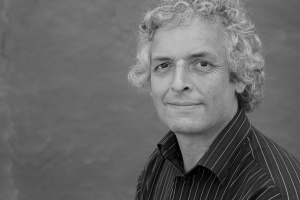
Martin Rauch
born 1958 in Schlins, Vorarlberg, Austria
"Rauch discovered clay architecture not through architecture, but through his education and his first projects as a ceramicist, oven builder and sculptor. His tendency towards applied craftsmanship, towards the thoroughly artistic autonomy of living and environmental design, was already predetermined by his family’s farming roots in Vorarlberg, although the decisive impulses for Rauch came to him abroad in that like some of his older siblings he worked for many months as an aid volunteer in Africa. The encounter with “primitive” means of existence and techniques of building in simple cycles and with the optimal use of resources occurred simultaneously to observing their brutal displacement by technologies from the First World that were extremely complex, ecologically far worse, difficult to repair, and non-recyclable.
In Africa his artistic impulse took on a global perspective. His subjective tendency to work with povera—primitive artistic material—found an objective, conceptual framework. The shaping of clay grew to a desire to architecturally design with earth. The molding of tiles and ovens became shaping and construction on a larger scale in the recasting of soil into inhabitable (spatial) figures. Instead of handing in the tea service called for by Matteo Thun for his diploma project at the University of Applied Arts Vienna, Rauch submitted a study on the potential of clay construction.
From the beginning onwards his interest was particularly focused on stamped-clay techniques, a method by which the material is not subject to any additional facing or enhancement. As in the case of unfired or low-fired unglazed ceramics, the fabrication of un-stuccoed pisé constructions (such as those Rauch also came across amongst anonymous outbuildings in France) led abruptly to an expression of itself. The layered erection of the wall simultaneously weaves the ornament of its own appearance. The pure structure, color and haptics of the material remain unaltered and intensively preserved in the process of forming and compression. With the sensitivity of the ceramicist for the composition and the physical-chemical conditions and effects of his material, Rauch set about to rearticulate the language of clay as a building material, to exhaust all the facets of the earthen material, whereby technical advances and enhancements went hand-in-hand with formal complexity. Step-by-step he experimented with and improved the natural mixture of materials, the compression techniques, the shape of the formwork, and developed the old techniques further using additional layers of reinforcement, but without departing from their structural frameworks. Tools, frame forms, working techniques were developed anew, test walls erected, and the experiences gathered in the single-handed execution of the structures put to immediate use in each subsequent series of tests."
Otto Kapfinger, "HAUS RAUCH", 2011, p.60
1974 Technical College of Ceramics and Oven Construction, Stoob. 1978–83 University of Applied Arts Vienna, master class in ceramics, under Matteo Thun and Maria Bilger-Perz. 1983 diploma “Loam Clay Earth,” honorary prize of the Austrian Federal Ministry of Science and Research. Since 1990 design, planning and realization of clay building projects at home and abroad. 1999 founding of the firm Lehm Ton Erde, Baukunst GmbH, 2007 of the firm ERDEN. 1988—2010 one-man and group exhibitions, in Feldkirch, Meran, Paris, and Graz, as well as numerous prizes and awards. Since 2003 lecturer at the University for Art and Industrial Design Linz. International workshops, in Bangladesh, South Africa, and Austria in co-operation with BASEhabitat. Since 2010 UNESCO Honorary Professor in the Chair of Earthen Architecture. Since 2014 guest lecuterer at Department of Architecture ETH Zurich (together with Anna Heringer).